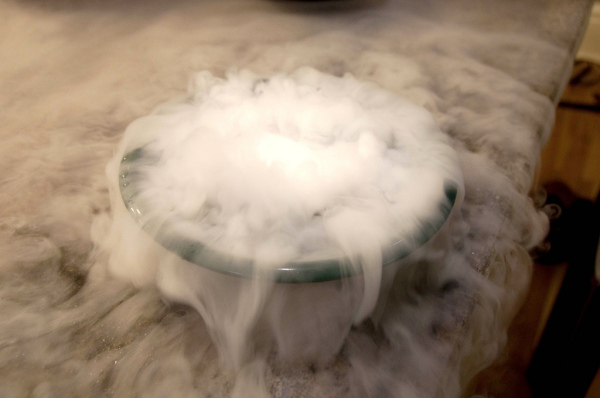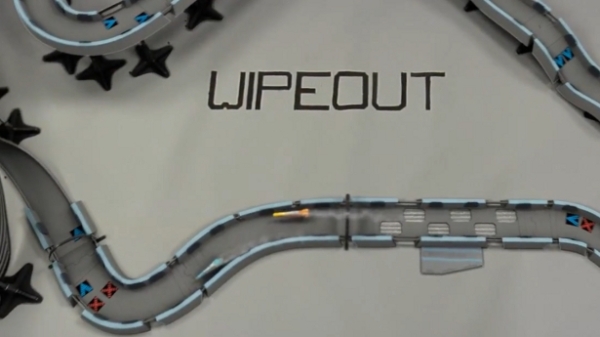
Scientists Reach A Temperature Lower Than Absolute Zero
Physicists at the Ludwig Maximilian University in Germany have hit a temperature lower than absolute zero, rewriting the laws of physics in the process.
Researchers Use Electricity To Release Human Brain's Strongest Opioid Painkillers

A team of international researchers have used a form of electro stimulation called transcranial direct current stimulation (tDCS) to release endrogenous opioids - the human body's most powerful painkillers that are similar in strength to morphine.
This noninvasive procedure is especially significant and rather scary, as this is an immediate natural high, which can be accessed using damp sponges on your scalp, attached to a 9-volt battery.
Researchers Create Walking Biological Robots Using Heart Cells

A team of scientists at the University of Illinois have built tiny biological robots that walk to the beat of a thin sheet of rat heart cells.
British Scientists Produce Petrol From Fresh Air

In no uncertain terms, this could be huge. In what could be a 'game-changer' for the global energy crisis and a step on the way to combating global warming, a small team of scientists from a company in the North-East of England have developed an 'air capture' technology that can produce synthetic petrol using little more than air and electricity.
We're Hiring: News Writers And Editors

Every day we are thankful to our audience of over 250,000 people for spending some of their precious time on this crazy planet we call Earth checking out the content we produce. And as these numbers grow on a daily basis, we realise that the team needs to grow alongside this. With this in mind, New Rising Media is looking to hire a load of news writers and editors from across the globe!
Girl Who Couldn't Move Her Arms Helped By 3D Printed Exoskeleton

At the age of 2, Emma wanted to play with blocks. But this wasn't possible due to a condition called arthrogryposis, meaning she couldn't lift her arms with her own strength. Traditional hospital treatment for this was superseded by a 3D printed exoskeleton (she calls them her "magic arms"), which aids her with all her movements.
NASA's Inflatable Heat Shield Passes Its Biggest Test Yet

Having travelled to a distance some 450 kilometres above the Atlantic Ocean and outside of Earth's atmosphere, before detaching from its launch rocket, inflating itself with nitrogen and proceeding to fall through Earth's atmosphere at hypersonic speeds, NASA's test of the latest iteration of inflatable heat shield has been a huge success.
Self-Confessed Science Geek Builds Hand-Crafted Particle Accelerator

July 3rd 2012 will go down in scientific history for the day in which scientists from CERN confirmed they had evidence of the elusive ‘God particle’, or Higgs Boson. But for designer Patrick Stevenson-Keating, it brought a new-found relevancy to his very own, working model of a particle accelerator made entirely out of common household objects. Namely, glass bulbs, a pump, magnets and some 45,000 volts.
Scientists Demo System That Charges Electric Cars Through Tyre-To-Road Contact

Electric cars are the future, so we're told. But even so, few still can put up a strong argument for favouring the green alternative to the gas-guzzling motors we have taken for granted for decades. For one; mileage ranges, while ever-improving, are still far from substantial for the average road user. Now, the era of the electric car is one step closer, with scientists ably demoing how electricity can be passed through concrete to charge cars on the move, paving the way for an electric motor future.
CERN Confirms Discovery Of New Particle Consistent With Higgs Boson

The European Organization For Nuclear Research have announced their observation of the heaviest boson particle ever found, which has given a strong case for proving the existence of the elusive Higgs.
'Science: It's A Girl Thing!' The Backlash Against The European Commission

The European Commission has made a great error. A frankly moronic error that makes them appear to be misogynistic idiots trying to sell a new perfume for teenagers called “Science”. But no, the following video isn’t advertising a new perfume (“with subtle hints of sulphur and a lingering scent of formaldehyde in a beautiful bottle designed to pay homage to the double helix”) it’s in fact trying to interest young women in science.
Brain-Activated Muscle Stimulation Restores Movement After Paralysis

All nerves and brain signals to operate your limbs go through the spinal cord, so most forms of paralysis occur due to damage of this area. But what if this was bypassed entirely, and your brain directly controlled these otherwise motionless limbs instead? This is a feat that researchers at Chicago's Northwestern University have been successful in carrying out.
NASA unveils hub for open source projects

Continuing with the initiatives NASA has been making to generate an open plain of communication and discussion surrounding scientific research, they have announced code.NASA: a central portal to "continue, unify, and expand NASA’s open source activities."
After just turning Alpha, some of the features are not present yet; but as is there's still much to be done. You can access information and resources from other users looking to make it big via the NASA open source route.

Real-life model Wipeout circuit powered by levitation. Real or fake?
We're not quantum physicists by any stretch of the imagination, but what we are is keen admirers of truly breathtaking science...especially when it recreates the same sort of racing you'd find in Sony's futuristic racer, Wipeout.
Artificial retinal implant restores vision
Tests on a new kind of prosthetic eye have proven successful, meaning that the technology could someday allow around 25 million people who are blind due to retinal diseases to see in crystal clarity, by having much stronger intercommunication when portraying the image to the brain.
Shiela Nirenberg and Chetan Pandarinath, of Weill Medical College of Cornell University in New York city have tested this retinal prosthetic in blind mice, discovering it gave them the power to see individual dimples on a baby's face. With this success comes the potential of human use.
MIT creates a chip that works like a brain

As we keep edging towards Skynet self sufficient artificial intelligence, MIT have taken a considerable step closer with their take on a Neuronal chip, mimicking the function of a synapse in the brain.


